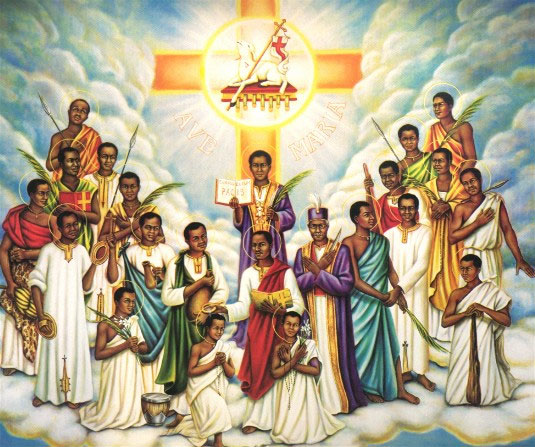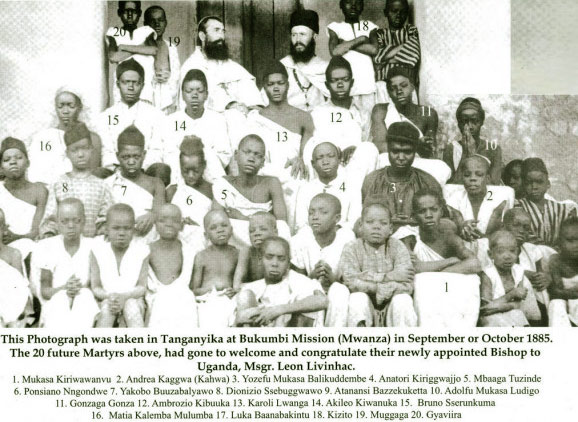45
Young Anglican
and Catholic
Martyrs
Who Gave their
Lives Together
for Christ in
Uganda
.
The
Uganda Martyrs are a group of 23
Anglican and 22 Catholic converts to
Christianity in the historical kingdom
of Buganda, now part of Uganda, who
were executed between 31 January 1885
and 27 January 1887.
The
Story of the Ugandan Martyrs
Christian missionaries, both Catholic and
Anglican, arrived in the interior of
Africa during the late nineteenth century.
The first of the Catholic missions was
established in what is now Uganda by a
missionary society called the White
Fathers. [The White Fathers took their
name not from the color of their skin but
from the color of their long tunic.] As
early as 1878, when he was asked by Pope
Leo XIII to take charge of the missions in
equatorial Africa, Lavigerie began a
series of annual caravan journeys to
central Africa as part of the Catholic
evangelization of the area. The next year,
a Catholic mission was founded in what is
now Uganda.
The largest and most powerful of the local
ethnic groups was the Baganda, a group in
which European missionaries took
particular interest. Edward Rice (a
friend, incidentally, of Thomas Merton)
offers an overview of the importance of
the region and the Baganda people in his
book Captain Sir Richard Francis Burton, a
biography of the Victorian explorer and
linguist. Rice recounts that the Baganda
were among the richest and most advanced
tribes in central Africa. Moreover, they
“bore a certain patina of civilization
that was to astound Europeans later, with
well-organized bureaucracies,
statesmanship of a superior order, finely
developed arts and architecture, and
unusual handicrafts.” Yet the civilization
also had a dark side, according to Rice,
with both rulers and subjects having the
reputation of being “unnaturally cruel.”
Mutesa, the ruler of the Baganda,
exemplified this cruel streak. When he
took the throne in 1860, to ensure his own
political survival he buried his brothers
alive—all sixty of them. Yet he adopted a
more or less benign approach to the
Christian missionaries. (Butler’s Lives of
the Saints calls him a “not unfriendly
ruler.”) In essence, Mutesa allowed his
subjects to choose among any of the faiths
being imported into his kingdom—Catholic,
Protestant, or Muslim. In turn, each group
attempted to assert its influence on the
king’s court through the conversion of
high-ranking officials. Mutesa, however,
pointedly did not choose any one creed. In
1884 he died, still adhering to the local
traditional religions.
Conversion to Christianity among the
Baganda meant a rejection of the
traditional religions. It also implied a
setting aside of some of the traditional
ways of life, an adherence to a new set of
moral and religious standards, and, often,
the establishment of a new set of
alliances, based on religious belief. As a
result, the group of new believers (called
abasomi, or readers) came to be
regarded with suspicion by other Baganda
as a dangerous rebel faction. During the
reign of Mutesa, however, these suspicions
were kept under check.
With the accession of his son, Mwanga, the
situation altered dramatically. As a young
man, Mwanga had shown some favor to the
Christian missionaries, but his attitude
changed as soon as he took the throne.
According to tradition, the kabaka
was the center of all authority and power
in the kingdom, and he could use his
subjects as he wished. But the presence of
the missionaries was severely diminishing
his authority among the converts. Mwanga
was also a practicing pedophile, and upon
discovering that the young men who had
converted to Christianity were beginning
to reject his sexual advances, he grew
enraged. As a result, the king sought to
eliminate Christianity from his kingdom
and began a violent persecution of the
missionaries and the new Christians.
In January of 1885, Mwanga had three
Baganda Anglicans— Joseph Rugarama, Mark
Kakumba, and Noah Serwanga— dismembered
and their bodies burned. In October of
that same year the newly arrived Anglican
bishop, James Hannington, was murdered
along with his caravan on their way to the
region. In response, Joseph Mukasa, a
senior adviser to the kabaka and a
recent Catholic convert, reproached Mwanga
for executing Bishop Hannington without
having offered him the customary
opportunity to defend himself. Mwanga,
furious at what he saw as Mukasa’s
insolence, had him beheaded on November
15, 1885. Mukasa became the first of the
black Catholic martyrs on the continent.
Among those now in obvious danger was the
head of the royal pages, Charles Lwanga,
who had been instructed in Christianity by
the White Fathers and who was now Mukasa’s
successor in guiding the young converts.
The day of Joseph Mukasa’s death, Lwanga
went to the Catholic mission with other
catechumens (those who were receiving
religious instruction), and together with
them he was baptized by Siméon Lourdel,
one of the White Fathers. Among the pages
was Kizito, age fourteen.
Their saga is retold by a current-day
White Father, Aylward Shorter, of the
Catholic University of East Africa, in
Nairobi. (Today this order has reverted
back to its official name, Missionaries of
Africa.) According to Fr. Shorter, the
next day the pages were summoned into the
royal court by the enraged kabaka. The
king had learned that one of the young
pages in his court, Mwafu, had been
receiving religious instruction from
another page, Denis Sebuggwawo. The king
demanded that the pages confess their
allegiance. All but three of the Catholic
and Anglican pages did so. Mwanga,
apparently baffled by this solidarity, put
off their executions. At one point Charles
Lwanga—echoing the stance of another,
earlier, martyr, St. Thomas More—stated
his allegiance to the kingdom of Buganda,
declaring his willingness to lay down his
life for the king. He would not, however,
abjure his faith.
In February, a fire in the royal palace
impelled Mwanga to move his court to a
lodge on the banks of Lake Victoria. While
there, Charles Lwanga protected several of
the pages against the king’s violent
sexual advances. Mwanga by this point had
already obtained the consent from his
chiefs to kill the Baganda Christians.
Around this time, Lwanga secretly baptized
five of the catechumens.
On May 26, the pages were called into the
royal courtyard to hear their fate. From
this point on, the story of the Ugandan
martyrs closely resembles those of the
early Christians. Fr. Lourdel, who had
repeatedly pleaded for an audience with
the king, was an unwilling witness. All of
the men declared that they were prepared
to remain Christians until death. In the
end, Mwanga decreed that all of
them—sixteen Catholics and ten
Anglicans—be marched to Namugongo, eight
miles away, where they would be burned. On
their way to execution, bound by ropes and
shackles, they were marched past Fr.
Lourdel, who would later attest to their
remarkably calm disposition.
They were marched to Namugongo, where,
bound with ropes, shackles, iron rings,
and slave yokes, they waited for one week.
During that time the martyrs prayed and
sang hymns; the Catholics among them
recited morning and evening prayers, grace
before and after meals, as well as the
Angelus and the rosary, in preparation for
their deaths. On June 3, before the
execution of the rest of the young men,
Charles Lwanga was put to death by the
king’s men. He was wrapped tightly in a
reed mat, a yoke was hung on his neck, and
he was thrown onto a pyre. Taunting his
executioners, Charles is said to have
shouted, “You are burning me, but it is as
if you are pouring water over my body!”
Before he died he cried out, “Katonda,”
or “My God.”
His companions were killed in the same
gruesome fashion. Aylward Shorter writes,
“As the flames rose, their voices could be
heard praying and encouraging one
another.” The last words of the young
Kizito were “Good-bye, friends. We are on
our way.”
In all, forty-five Christians were
martyred at Namugongo: twenty-two
Catholics and twenty-three Anglicans.
Again the story brings to
mind the tales of the early Christian
martyrs and recalls a quote from the
third-century Christian writer Tertullian:
“As often as we are mown down by you, the
more we grow in numbers; the blood of
Christians is the seed.” For after the
White Fathers were expelled from the
region, the Baganda Christians continued
with the process of evangelization,
translating the catechism into Luganda,
offering secret instruction in the faith,
and encouraging one another to persevere.
Upon their return after Mwanga’s death,
the White Fathers discovered five hundred
Christians and more than a thousand
catechumens awaiting further instruction.

In 1964, Pope Paul VI canonized all
twenty-two of the Catholic martyrs. Five
years later, as the first pope to visit
sub-Saharan Africa, he laid the foundation
stone of the shrine to be built in
Namugongo in honor of St. Charles Lwanga
and his companions. The shrine was
completed in 1975, on June 3, now the
feast day of the Ugandan martyrs.
source:
https://www.americamagazine.org/content/all-things/story-ugandan-martyrs
Marvelous Growth of
Christianity in Uganda
by James Kiefer
On 3 June 1886, thirty-two young men, pages of
the court of King Mwanga of Buganda, were burned
to death at Namugongo for their refusal to
renounce Christianity. In the following months
many other Christians throughout the country
died by spear or fire for their faith.
These martyrdoms totally changed the dynamic of
Christian growth in Uganda. Introduced by a
handful of Anglican and Roman [Catholic]
missionaries after 1877, the Christian faith had
been preached only to the immediate members of
the court, by order of King Mutesa. His
successor, Mwanga, became increasingly angry as
he realized that the first converts put loyalty
to Christ above the traditional loyalty to the
king. Martyrdoms began in 1885. Mwanga first
forbade anyone to go near a Christian mission on
pain of death, but finding himself unable to
cool the ardor of the converts, resolved to wipe
out Christianity.
The Namugongo martyrdoms produced a result
entirely opposite to Mwanga's intentions. The
example of these martyrs, who walked to their
deaths singing hymns and praying for their
enemies, so inspired many of the bystanders that
they began to seek instruction from the
remaining Christians. Within a few years the
original handful of converts had multiplied many
times and spread far beyond the court. The
martyrs had left the indelible impression that
Christianity was truly African, not simply a
white man's religion. Most of the missionary
work was carried out by Africans rather than by
white missionaries, and Christianity spread
steadily. Uganda now has the largest percentage
of professed Christians of any nation in Africa.
Several years ago I heard an African clergyman,
born of pagan parents, tell of his conversion.
He said:
One afternoon I was bicycling along
a road and met a young man about my own age
bicycling in the opposite direction. He
promptly turned about and began to ride beside
me and to talk. He spoke with great enthusiasm
about Jesus, whom I had never heard of before,
and how He had destroyed the power of death
and evil by dying and rising again, and how He
was God become man to reconcile man with God.
I heard what my companion had to say, and
before we parted I had accepted Jesus Christ
as my Lord and Savior. Now, the young man who
preached the Good News of Jesus Christ to me
that afternoon had himself heard of Jesus for
the first time that morning.
Renewed persecution of Christians in the 1970's
by the military dictatorship of Idi Amin proved
the vitality of the example of the Namugongo
martyrs. Among the thousands of new martyrs,
both Anglican and Roman, was Janani Luwum,
Archbishop of the (Anglican) Church of Uganda.
Africa is critical
for the future of global Christianity.
In the next 10 years, Africa will
likely grow to have the most
Christians of any continent: 700
million.
www.globalchristianity.org
|
|

